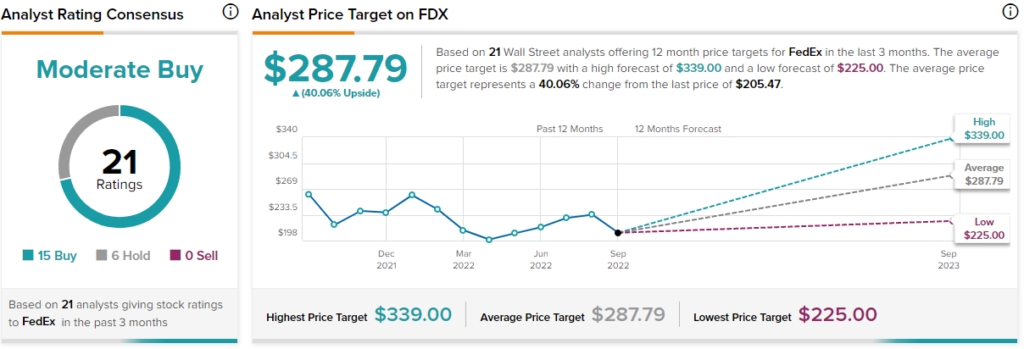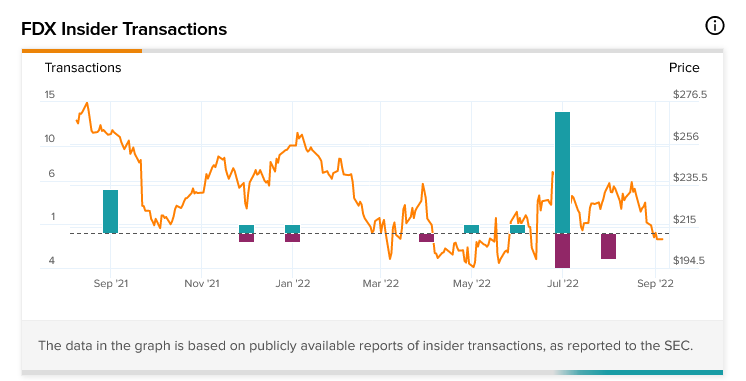Shipping giant FedEx (NYSE: FDX) had something of a post-Labor Day hangover. The former pandemic darling is lagging the market today. The biggest reason for FedEx’s slip is a recent downgrade at Citigroup (NYSE: C). Analyst Christian Wetherbee lowered his price target on FedEx to $225 per share and also dropped the company down from Buy to Neutral. Citi expects that FedEx will likely have some trouble producing growth in earnings-per-share figures this year, which will hurt share prices.
Granted, Citigroup’s thesis is a valid one, and it may be a good idea to take a wait-and-see approach here, especially if those new potential lows materialize. That being said, though, I’m bullish on FedEx. The near-term outlook may be murky. However, FedEx is a pretty safe bet to run for as long as there’s a functioning economy.
The last 12 months for FedEx shares have been wildly erratic. This time last year, FedEx was challenging $260 per share. That led to a substantial slip days later, as, by September’s end, FedEx was pushing $210 per share. Rallies and plunges followed for the next several months. Now, FedEx is trading at around $205 per share. That’s well off its highs and threatening new lows.
Is FedEx Stock a Buy, Hold, or Sell?
Turning to Wall Street, FedEx has a Strong Buy consensus rating. That’s based on 16 Buys and five Holds assigned in the past three months. The average FedEx price target of $287.79 implies 40% upside potential.
Analyst price targets range from a new low of $225 per share from Citigroup to a high of $339 per share.

A Troubling Mix in Investor Sentiment Figures
Analysts are very bullish on FedEx right now, and they’re not alone. In fact, FedEx currently carries a Smart Score of 9 out of 10 on TipRanks. That’s the second-highest score period, as well as the second-highest level of “outperform.” It’s pretty clear that most see FedEx as likely to outperform the broader market.
However, that’s not the case all around. Insider trading at FedEx is starting to swing negative by some measures. While buying activity is outpacing selling activity, virtually all of the informative moves in the last three months have been Sells.

Just one Informative Buy took place in that time, with director Amy Lane buying $138,464 worth of stock two months ago. Multiple Informative Sells took place after Lane’s purchase.
While informative transactions are screaming “sell,” the aggregate is a different story. In the last three months, buyers led sellers 14 to seven. Meanwhile, for the full year, that expands to 23 Buys to 10 Sells.
Looking Past the Near-Term to See a Brighter Future
I’m not going to take anything away from Citigroup’s analysis here. They’re absolutely right. The near-term for FedEx does look murky. Its ability to generate improvement in earnings per share will be difficult for a while.
Certainly, FedEx will get a boost from the upcoming holiday shopping season. While most households are likely poised to pare back spending, there will likely be some spending taking place. After that fades, there will be a slow drop as the holiday purchases shift to holiday returns and then hit the winter blahs for the next several months.
However, it’s what will likely happen afterward that keeps me looking up. FedEx is, for example, looking to bolster its cross-border operations throughout the Asia-Pacific, Middle East, and Africa (AMEA) region.
E-commerce sales in that region are expected to top $100 billion by the end of next year. FedEx’s move to become the dominant shipper therein helps ensure a piece of that market.
Further, FedEx has built itself some marketing credibility by landing top honors at the International Air Transport Association’s (IATA) cargo carrier lists. FedEx truck drivers also distinguished themselves at the National Truck Driving Championships.
FedEx is also making a name for itself with “Picture Proof of Delivery.” That measure, started back in June, calls for delivery personnel to photograph shipments that arrived at their destination.
There are some signs of trouble, though, as FedEx’s rate of growth is slower than some of the other carriers looking to land that top slot. FedEx’s own growth rate was actually the third lowest on the IATA’s list. That may prompt some problems later on.
However, everyone else is likely to see some rates diminish before too much longer, thanks to a global economic slowdown. Some FedEx contractors are looking to abandon holiday deliveries as well, a point that will hurt FedEx’s perceptions of reliability. Yet, contractors losing money on FedEx business will likely do significantly more harm.
The key point here is that anything that’s likely to hurt FedEx is likely to hurt its competitors as well. If there are fewer packages in the system, then there will be fewer deliveries.
Everyone should end up with about the same proportion of a smaller pie. FedEx is clearly working on expanding its market share. Though those efforts may ultimately prove of limited value, at least for now, they should give FedEx at least some edge.
Conclusion: FDX is the Best Choice in a Declining Lot
While FedEx certainly has competition—like perennial shipping mainstay United Parcel Service (NYSE: UPS)—it’s been able to stay mostly ahead of that competition for years. While we’re in a period of economic slowdown, that slowdown is hitting everybody about as hard. FedEx is pursuing comparatively new markets that are still in the midst of expansion as a means to respond.
It’s not clear how successful those measures will be, ultimately. However, just making an attempt should give investors a vote of confidence. With FedEx already trading well under even its lowest price target—under even the latest lowered target out of Citigroup—FedEx should be able to offer value in the short term and the long term alike.
That’s why I’m bullish on FedEx. It’s worked hard to keep its position, although it can certainly lose some ground in the near term. That will likely change when the economy itself turns around. Even if it doesn’t change any time soon, FedEx’s work to expand new markets and keep itself at the top of the heap can’t go without potential investors seeing the value therein.
















